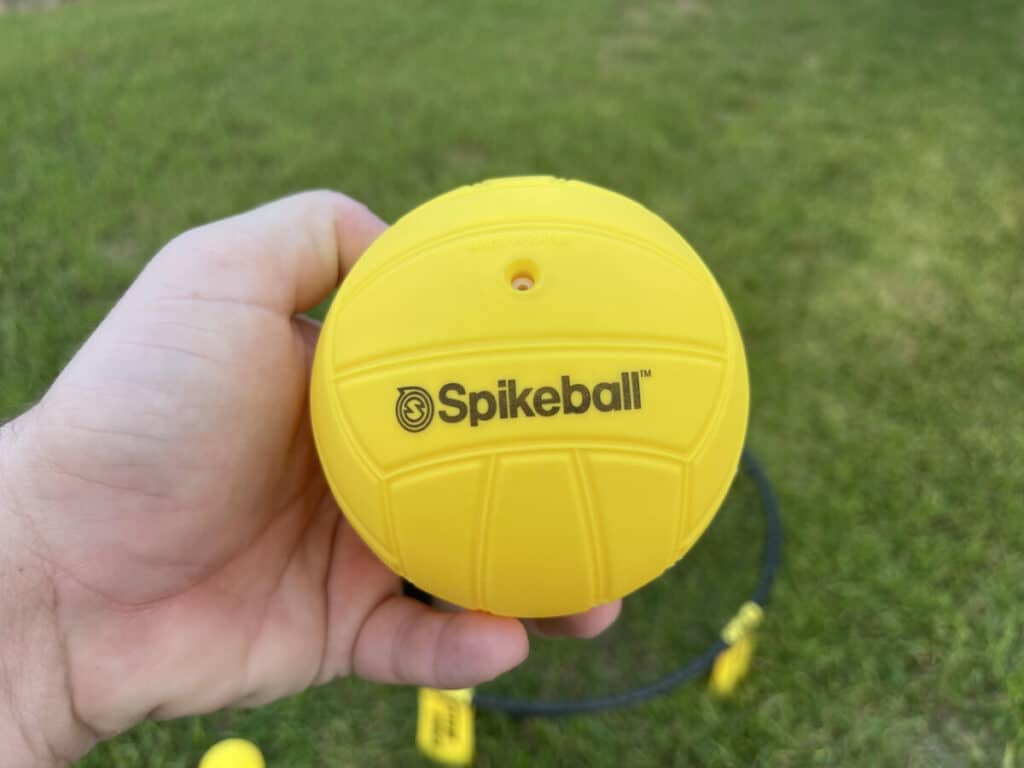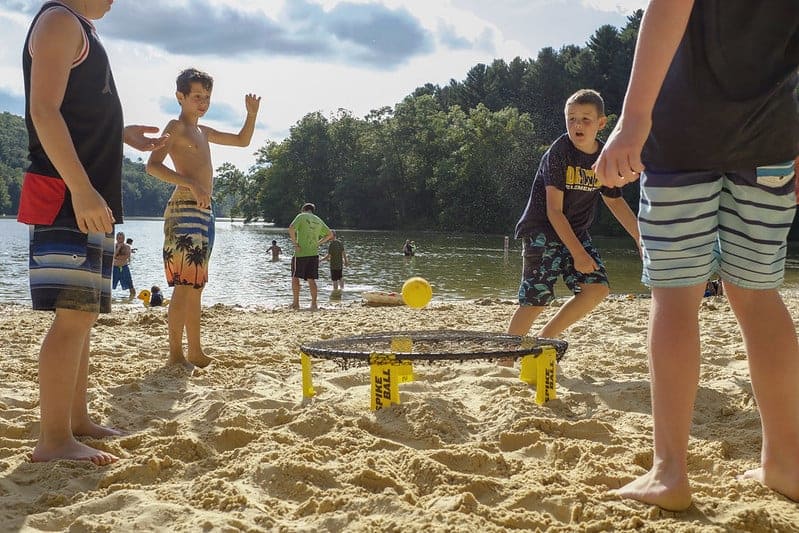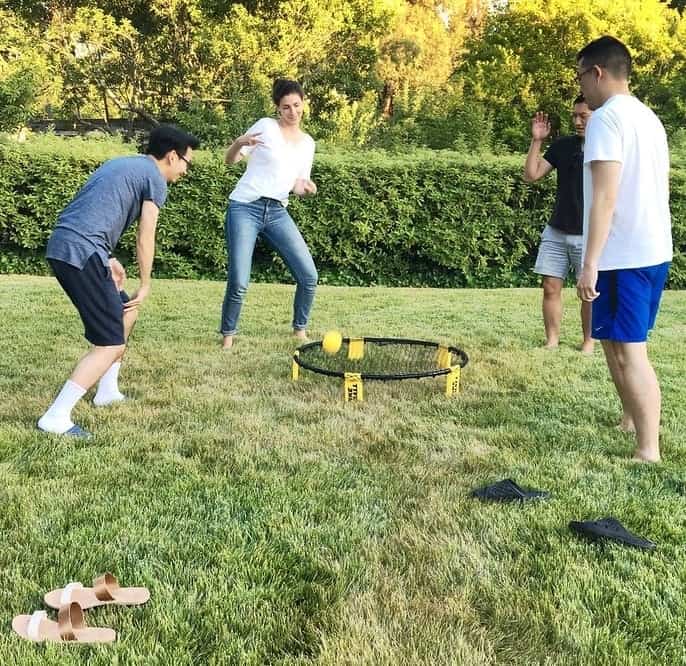Spikeball is a fairly new game that’s becoming very popular and well-known. It’s an easy option for casual settings because of how small the equipment is, how diverse the game options are, and is easy to play for a wide variety of ages and skill levels.
Spikeball is a great combination of the ideas you find in volleyball and four-square. It’s usually played in a 2-on-2 format but easily adapts to a variety of the number of players. The game action focuses on spiking the ball down onto the net to ricochet the ball back up into the air.
For millions around the globe who have grown up playing 4-square on the playground or in PE class, Spikeball and roundnet are a very natural fit because of the similarities in how it’s played. The simple mechanics and the flexibility of casual rules make it easy to adopt and add to your list of fun backyard, tailgating, or beach games.

What’s the Difference Between Spikeball and Roundnet?
You may hear the terms Spikeball and Roundnet used interchangeably. While this is common, if you want to sound like you know what you’re talking about, it may help to understand the difference!
The easiest way to think about it is that Spikeball is the most popular brand name, while Roundnet is the name of the sport. Roundnet is actually the competitive version of the game that’s governed by the International Roundnet Federation.
While you may hear people say “let’s go play Spikeball,” it would be more correct to say, “let’s go play roundnet.” Otherwise, it’s kind of like saying, “let’s go play Spalding.” Imagine how confusing THAT would be! In the early days, Spikeball was the only brand and therefore it was common to refer to both with the same name, but the Spikeball company actually decided to differentiate the sport to protect their brand name.

What Sport is Spikeball or Roundnet Similar To?
At first glance, Spikeball definitely resembles four-square and echoes volleyball. But once you actually watch in motion and understand the rules, you may be reminded of some other sports. Just like many of our sports, you can see roundnet is a mashup of ideas and principles from several different sports:
| Sport | Similar Attributes |
|---|---|
| Volleyball | play begins with a service a team has 3 hits before having to play the ball to the opponents no double hits allowed rallies continue until a rule is broken or the ball falls to the ground players rotate after serving whoever wins the point serves the next rally rally scoring – every play results in a point winners must lead by 2 points |
| Beach Volleyball | 2-on-2 teams players line up side-by-side with teammates to work together can be played on sand games are usually played to total of 11, 15 or 21 points |
| Four-square | the ball is directed down so that the opponent has to play a ricochet |
| Squash | using spin and keeping the ball low can really challenge receivers the mechanics of the game may use gravity to increase power and speed |
| Trampoline | the net is basically a trampoline for the ball |
| Tennis | servers get 2 tries for a legal serve serves that are not legal are called faults |
Roundnet Gameplay
- The first service of the game is decided by a game of rock-paper-scissors. The winner gets to choose whether they would like to serve or receive.
- At the beginning of the point, players line up side-by-side with their teammates and across from their opponents. In the 2-on-2 version, this means you will begin by forming a square, each player 90 degrees apart. Whoever is receiving the service may stand wherever they want before the serve, while everyone else has to be at least 6 feet from the rim of the net.
- During the service, the ball must clear the rim for the play to continue. If the ball bounces a second time on the net, then a double bounce is called the receivers win the point.
- Contact with the rim at any point is a fault. Whichever team hit the rim loses that point.
- After the ball is put into play, players are free to roam and play all the way around the net. This is a 360-degree game!
- Possession changes from one team to the next each time the ball hits the net. Your team has up to 3 hits to play the ball, but that’s optional, you don’t need to use them all.
- You may hit the ball with any part of your body.
- Players have to alternate hits, so no double hits are allowed. This means that once a player has touched the ball with any part of their body, they can’t touch it again with any other part of their body or it would count as a double hit.
- The ball must be hit, players are not allowed to lift, carry, or throw the ball.
- Two-hand hits are not allowed. Not only is it against the rules, it actually costs your team a point!
- Defensive players must make their best effort to get out of the way of play. If they interfere, offensive players may call a “hinder” and the point is replayed.
- If offensive players hit a shot that hits the net and then themself or a teammate, they automatically lose the point.
- If a player makes contact with the net at any point during play, their team loses the point.
- If the serving team wins the point, they retain the serving possession and rotate server and receiver. If the receivers win the point they get to serve next.
- To encourage fairness because of varying conditions outside, players should rotate their serving positions 90 degrees after every 5 points. This helps make up for the differences in wind, sunlight, or ground conditions.
- Roundnet uses rally scoring, meaning someone scores a point on every play, you don’t need possession of the service to win a point.
- Games are played to a total of 11, 15, or 21 with a 2-point lead.

Popular Optional Spikeball Rule Variations
Would you like to mix it up and challenge yourself and your friends to a more unique roundnet experience? Adding some “house rules” from time to time can really spice things up!
Split the field of play.
If everyone has to stay on their own half of the circle it actually makes the game simpler.
Only 1 Hand
If you are limited to only using 1 hand, it’s surprising how much harder the game becomes.
Holding Hands
Try this, you have to hold hands with your teammate(s) the entire time, WHAT?! That’s crazy, right?
3 Player Game
If you’re stuck with 3 players, a common way to handle this is to have player 3 be an all-time setter and defender. The idea is they can hit the first or second touch for both teams, but they never spike the ball.

What’s the Difference Between Slammo and Spikeball?
These are 2 different brand names of the equipment made for the same sport. The sport itself is called roundnet and either of these can be your brand of choice.
The most noticeable difference when you see Slammo instead of Spikeball will be the bright green branding instead of the signature yellow. Reviewers say that the Slammo ball is a little lighter and bouncier than the original Spikeball version. The only other difference seems to be that the leg height of the net is not adjustable.
If you’d like to compare and shop for them on Amazon you can find them here:
Are Spyderball and Spikeball the Same Thing?
Spyderball is a different brand, so you may want to consider comparing the price and quality differences. As with any product, the quality of the leading brand is likely going to be far superior, but you are also going to pay a higher price. In this case, Spikeball is the originator and the leading brand, Spyderball offers a very low-cost alternative.
Resources:
International Roundnet Federation
Wikipedia: https://en.wikipedia.org/wiki/Roundnet
Photo Credits:
Feature image and ball closeup images contributed by Josh With Yard Diversions
Six-player game image by Elvert Barnes on flickr.com: https://creativecommons.org/licenses/by-sa/2.0/
Spikeball on the sand image by Ryan Dickey on flickr.com: https://creativecommons.org/licenses/by/2.0/
Four-player game image by P C on flickr.com: https://creativecommons.org/publicdomain/zero/1.0/
Recent Posts
Athletes, listen up! Do you have a closet full of old jerseys, sweatpants, and tees that you just can't seem to part with? Well, dust them off, because you're sitting on a goldmine of fashion...
You may have heard, or you may have noticed, that there's been a change to the rule about double contact in volleyball. In 2022, an experimental rule change began to be implemented, where the double...
